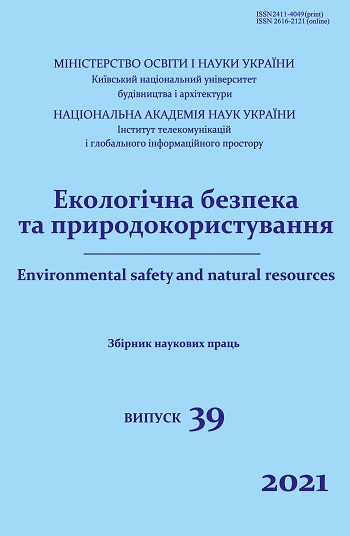Research of heavy metals leaching from sediments after feritization processing of galvanic sludge
DOI:
https://doi.org/10.32347/2411-4049.2021.3.76-87Keywords:
galvanic waste, ferritization, leaching, heavy metalsAbstract
Possibility of environmental safety increasing for industrial enterprises as a result of resource-saving technology implementation for processing galvanic sludge is considered. An experimental study of stability for sediments after ferritization processing of galvanic sludge and exhausted technological solutions was carried out. As a result of dynamic leaching of heavy metal ions, the immobilization properties of sediments were determined, which were obtained at different technological parameters of the ferritization process. It is shown that the level of immobilization of heavy metals in ferritic sediments has significantly higher values in comparison with sediments of traditional wastewater neutralization. It was found, that the precipitate obtained at following key parameters of reaction mixture for the ferritization process: the total concentration of heavy metal ions 10.41 g/dm3; ratio of concentrations of iron ions to total concentration of other heavy metals ions 4/1 and pH value of 10.5, is characterized by the highest degree of immobilization of heavy metals in the sediments of 99.96% mass. Using the results of a complete factorial experiment, regression equation for the leaching of heavy metal ions (iron, nickel, copper and zinc) from ferrite sediments was obtained: ratio of iron concentrations to the total concentration of other heavy metals and the pH value of reaction mixture. The adequacy of coefficients of regression equations was evaluated according to the criteria of Student and Fisher, which with 95% reliability correspond to the experimental results of the study. The proposed calculation algorithm provides an opportunity to increase efficiency and automation of ferritization process. Subsequent use of the research results will allow to implement reliable utilization of ferritized galvanic waste by application them into the row materials for obtaining alkaline cements for special purposes.
References
Derzhstat Ukrainy. (1998‒2021) [in Ukrainian].
Zueva, S., Ferella, F., Ippolito, N.M., Ruduka, E., & De Michelis, I. (2021). Wastewater Treatment from Galvanization Industry with Zinc recovery. E3S Web of Conferences, 247, 01064. https://doi.org/10.1051/e3sconf/202124701064.
Marcus, M.-I.,Vlad, M., Deak, G., Moncea, A., Panait, A.-M., & Movileanu, G. (2020). Thermal stability of inorganic pigments synthesized from galvanic sludge. Revista de Chimie, 71(8), 13-20. https://doi.org/10.37358/rc.20.8.8274.
Vitkalova, I.A., Uvarova, A.S., Pikalov, E.S., & Selivanov, O.G. (2020) Lanthanum oxide application for modifying the properties of chemically resistant ceramics produced with galvanic sludge additive. International Journal of Emerging Trends in Engineering Research, 8(8), 4544-4547. https://doi.org/10.30534/ijeter/2020/81882020.
Tsvetkov, M.P., Milanova, M.M., Cherkezova-Zheleva, Z.P., Abrashev, M.V., & Mitov, I.G. (2021). Catalytic and photocatalytic properties of zinc-nickel ferrites. Journal of Chemical Sciences, 133(1), 24. https://doi.org/10.1007/s12039-020-01882-2.
Zhang, J., Gao, X., Ma, D., Xie, L., & Deng, Y. (2021). Copper ferrite heterojunction coatings empower polyetheretherketone implant with multi-modal bactericidal functions and boosted osteogenicity through synergistic photo Fenton-therapy. Chemical Engineering Journal, 422, 130094. https://doi.org/10.1016/j.cej.2021.130094.
Zhang, Y., He, H., Wang, H., Chen, G., An, X., & Wang, Y. (2021). Evolution of microstructure and mechanical properties of Cr ferrite/martensite steels with different Si content after long-term aging at 550 °C. Journal of Alloys and Compounds, 873, 159817. https://doi.org/10.1016/j.jallcom.2021.159817.
Yemchura, B., Kochetov, G., Samchenko, D., & Prikhna, Т. (2021). Ferritization-Based Treatment of Zinc-Containing Wastewater Flows: Influence of Aeration Rates. Environmental Science and Engineering, 171-176. https://doi.org/10.1007/978-3-030-51210-1_29.
Birčáková, Z., Füzer, J., Kollár, P., Bureš, R., & Fáberová, M. (2019). Magnetic properties of Fe-based soft magnetic composite with insulation coating by resin bonded Ni-Zn ferrite nanofibres. Journal of Magnetism and Magnetic Materials, 485, 1-7. DOI: https://doi.org/10.1016/j.jmmm.2019.04.060.
Marciniak, K., Grabowska, K., Stempien, Z., Rutkowska, A., & Taranek, D. (2016). Woven fabrics containing hybrid yarns for shielding electromagnetic radiation. Fibres and Textiles in Eastern Europe, 24(6), 120, 109-115. DOI: https://doi.org/10.5604/12303666.1221744.
Antipov, V.B., Potekaev, A.I., Vorozhtsov, A.B., Melentyev, S.V., & Tsyganok, Y.I. (2016). Radio-Absorbing Nanocoatings on Corrugated Surface. Russian Physics Journal, 59(8), 1225-1230. DOI: https://doi.org/10.1007/s11182-016-0895-4.
Krivenko, P.V., Kovalchuk, O.Yu., Kyrychok, V.I., & Guziy, S.G. (2015). Sulfate resistance of alkali activated cements. Materials science forum, 865, 95-106. DOI: https://doi.org/10.4028/www.scientific.net/MSF.865.95.
Kovalchuk, O., Kochetov, G., & Samchenko, D. (2019). Study of service properties of alkali-activated cement using wastewater treatment residues. IOP Conference Series: Materials Science and Engineering, 708 (1). 012087. https://doi.org/10.1088/1757-899X/708/1/012087.
Kovalchuk, O., Kochetov, G., Samchenko, D., & Kolodko, A. (2019). Development of a technology for utilizing the electroplating wastes by applying a ferritization method to the alkalineactivated materials. Eastern-European Journal of Enterprise Technologies, 2/10, 98, 27-34. doi: https://doi.org/10.15587/1729-4061.2019.160959.
Kochetov, G.M., Prikhna, T.O., Samchenko, D.M., & Kovalchuk, O.Yu. (2019). Development of ferritization processing of galvanic waste with energy saving electromagnetic pulse activation of the process. Eastern-European Journal of Enterprise Technologies, 6/10, 102, 6-14. DOI: https://doi.org/10.15587/1729-4061.2019.184179.
Yemchura, B., Kochetov, G., & Samchenko, D. (2018). Ferrit cleaning of waste water from zinc ions: influence of aeration rate. Problems of Water supply, Sewerage and Hydraulic, 30, 14-22. https://doi.org/10.32347/2524-0021.2018.30.14-22.
Kochetov, G., Kovalchuk, O., & Samchenko, D. (2020). Development of Technology of Utilization of Products of Ferritization Processing of Galvanic. Waste In The Composition of Alkaline Cements. Eastern-European Journal of Enterprise Technologies, 5(10-107), 6-13. https://doi.org/10.15587/1729-4061.2020.215129.
Statiukha, H.O., Skladannyi, D.M., & Bonarenko, O.S. (2011). Introduction to planning the optimal experiment. IVС «Politekhnika» [in Ukrainian].
Bakhrushyn, V.Ie. (2011). Methods of data analysis [in Ukrainian].
Downloads
Published
How to Cite
Issue
Section
License
Copyright (c) 2021 Dmitry N. Samchenko, Leonid I. Potapenko, Gennadii М. Kochetov, Oleksandr Y. Kovalchuk, Aleksey Vasiliev, Oksana M. Nechipor

This work is licensed under a Creative Commons Attribution 4.0 International License.
The journal «Environmental safety and natural resources» works under Creative Commons Attribution 4.0 International (CC BY 4.0).
The licensing policy is compatible with the overwhelming majority of open access and archiving policies.

